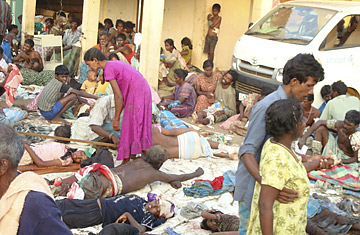
Sri Lankan ethnic Tamil victims wait outside a makeshift hospital inside the Tiger controlled "No Fire Zone" in Mullivaaykaal, Sri Lanka, Sunday, May 10, 2009.
Humanitarian agencies have been warning for months that there would be huge civilian casualties if the Sri Lankan Army and the Liberation Tigers of Tamil Eelam continued their fight to the death with thousands of unarmed people caught between them. No one paid much heed to the desperate warnings except for the relief agencies themselves, and on Sunday, they appeared to prove correct.
On May 10, a doctor working in a makeshift hospital inside the shrinking war zone in northern Sri Lanka told the Associated Press that 378 civilians had been killed and 1,100 injured due to heavy fire within the area demarcated as a no-fire zone by the government. The death toll kept rising as the day wore on. "Seeing the number of wounded and from what the people tell me, I estimate the death toll to be around 1,000," said Dr V Shanmugaraja. Early in the morning on May 12, the same hospital, located in the village of Mullivaikal, was hit again, and some of those injured in the weekend attacks were killed, according to pro-LTTE websites claiming the heavy artillery fire came from the government side.
The Sri Lankan government has denied that government forces were responsible for the attack and called the doctor's report a fabrication. "There is absolutely no way that this doctor could have used a telephone, dialed BBC, or CNN or al-Jazeera, and said that the shelling was coming from the government side and so many people have been killed," says Mahinda Samarasinghe, Sri Lankan Minister for Human Rights and Disaster Management. No one within areas held by the Tigers can act independently and are under pressure from the Tigers, Samarasinghe says. "There may have been a gun pointed at the doctor's head to say what he had to say." The government also says it has no record of a doctor named Shanmugaraja registered with the Ministry of Health working inside the combat zone since October 2008. "It could have been anybody, it could have been [Tiger leader Velupillai] Prabhakaran's son," said Samarasinghe.
The UN spokesperson Gordon Weiss said on May 10 that doctors serving inside the shrinking combat zones have proved reliable in the past — a statement that drew sharp condemnation from Colombo. "Mr. Gordon Weiss should be a lot more discreet about what he says in public, given the sensitivities involved, especially at a time when emotions are running high, not only in Sri Lanka, but elsewhere as well," Foreign Secretary Palitha Kohona said. Weiss has overstepped his mandate, Kohona says, effectively giving a stamp of authenticity to unverified claims about the war. The Sri Lankan government has made it all but impossible to verify any claims about events inside the war zone by refusing requests for unmonitored access by independent journalists.
UN Secretary General Ban Ki-moon also reminded both parties soon after the weekend battles that "the world is watching Sri Lanka and would not accept further violations of international law." The five-member Security Council already held an informal session about Sri Lanka on April 11, and some members have lobbied for wider UN action. But moves to initiate a formal Security Council session on Sri Lanka have been thwarted by China and Russia. The government sees this effort to apply diplomatic pressure — through UN action or a debate at the Geneva-based UN Human Rights Council — as, in effect, giving aid to the Tigers.
What is not debatable is that thousands of civilians remain trapped in a very small area with their lives at tremendous and increasing risk. The United Nations estimates that 50,000 people remain trapped in the six-square-kilometer area still controlled by the Tamil Tigers, which have been fighting for a separate ethnic Tamil homeland since 1983. The Sri Lankan government says there are no more than 15,000 to 20,000. The LTTE holds only this small strip of territory on Sri Lanka's northeastern coast within an area designated by the Army as a so-called safe zone. Over the weekend, the Army announced that it had re-demarcated the safe zone, chopping it down to just 2.5 km long. The Army did not specify how it informed civilians that their safe area had been shrunk; in the past, it would use loudspeakers positioned on the front line.
The LTTE, meanwhile, continues to use the remaining civilians as human shields, according to the Army and human rights groups. Military sources say that the Tigers have moved the civilians away from the perimeter of the war zone, where they could escape as soon as the Army advanced, into the area's middle where the Mullivaikal hospital is located. On April 20, an estimated 100,000 civilians fled the zone within 72 hours when the Army breached a major Tiger fortification. Sri Lankan troops advanced a further 300 meters into Tiger territory on Tuesday. "We still believe that thousands of people, men, women and those vulnerable remain trapped inside the combat area," says Sarasi Wijeratne ICRC spokesperson. "There is hardly any safe area left for these people to move in, and their lives are in great danger."
